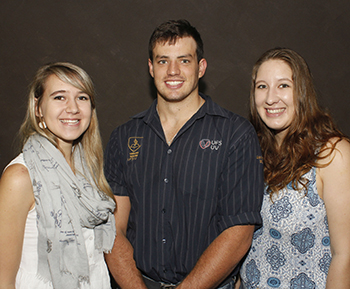
Thania Labuschagne, Nico Oosthuizen, and
Suthea van der Westhuizen.
Photo: Supplied
Reformation 500: Sola Scriptura [scriptural authority] and contemporary conflicts of interpretation was the theme for the Faculty of Theology and Religion’s official opening and annual Open Day on the Bloemfontein Campus of the University of the Free State (UFS). The faculty was recently renamed to be more inclusive of other denominations, as well as to be sensitive to the impact religion has on society, both in the past and presently.
In his welcoming address to first-year students, Prof Fanie Snyman, Dean of the Faculty of Theology and Religion, said, “I hope that you indulge in the theological dish served to you, and that it will create in you a deep hunger to know more.”
One first-year, Neo Kgaje, had this to say, “I first wanted to do Archaeology, but then I decided to follow my calling as a missionary and study Theology. I would like to serve in my own community in Botshabelo.”
Thania Labuschagne, former chairperson of the Sola Gratia student association, said, “The annual opening is always very special for me. We become part of a family here.” Her message for first-years was, “Maintain your passion for what you do. Make sure of your calling, and everything else will fall into place.”
Prizes awarded
Prizes were awarded to several students who excelled in the previous year. The best third-year student in 2016 was Suthea van der Westhuizen; best fourth-year BTh student, Thania Labuschagne; and Nico Oosthuizen was recognised as the best Master of Divinity in the fifth year.
The Director of Shepherd Centre for spiritual leaders, Dr Gerhard Botha, awarded certificates for the completion of a 9-module short learning programme presented by the centre.
"May you hunger to know more"—
Prof Fanie Snyman, Dean of the
Faculty of Theology and Religion
Current affairs addressed through scriptural analysis
While acknowledging that the debates around the authority of Scripture are complex and not easily resolved, Prof Hendrik Bosman from the Faculty of Theology at Stellenbosch University (SU) argued that it is an indispensable precept of Christian theology. However, it can no longer be taken as a given, since the authority of Scripture is increasingly vulnerable. He said, “Sceptic academics and critical theologians are challenging the more traditional ways of accepting the authority of Scripture.”
Prof Bosman highlighted the negative impact that certain claims of scriptural authority have had on the marginalised and vulnerable groups in society — “the suffering endured by people of colour, Jews, the LGBTQI community, and women due to prejudice and hatred. … [When reading the Bible], one must also be held accountable by the marginalised and the vulnerable in society.”
Prof Juliana Claassens (Faculty of Theology, SU) presented Beyond Revenge: Responsible Bible Reading Practices in a Traumatised Land. “As a community of believers who hold dear the principle of Sola Scriptura, what do we do with texts that revel in the downfall of the enemy and propagate revenge as a viable solution to the hurt and pain people are experiencing?”
Prof Claassens continued, “This question is particularly relevant given the deep wounds that many in this beautiful country of ours carry. … There is thus a real danger that expressions of violence survive and grow ever stronger with each utterance, until the violent ideas they propagate are considered to be normal.” Her recommendation? “Foster communities of care, focused on breaking down walls, instead of erecting them.”